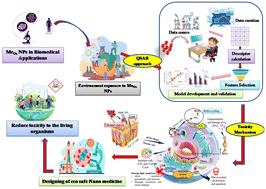当前位置:
X-MOL 学术
›
Environ. Sci.: Nano
›
论文详情
Our official English website, www.x-mol.net, welcomes your
feedback! (Note: you will need to create a separate account there.)
Risk assessment and data gap filling of toxicity of metal oxide nanoparticles (MeOx NPs) used in nanomedicines: a mechanistic QSAR approach
Environmental Science: Nano ( IF 5.8 ) Pub Date : 2022-07-20 , DOI: 10.1039/d2en00303a Joyita Roy 1 , Kunal Roy 1
Environmental Science: Nano ( IF 5.8 ) Pub Date : 2022-07-20 , DOI: 10.1039/d2en00303a Joyita Roy 1 , Kunal Roy 1
Affiliation

|
Nanotechnology has become a fast-growing area of science. Recently, there has been an increase in the use of metal oxide nanoparticles (MeOx NPs) due to their unique morphology and physical properties. The application of MeOx NPs in nanomedicines has opened up new perspectives for medical devices and development in health care. Nanomedicines and nanotoxicity are complementary to each other. Lack of sufficient data and low-adequacy experimental setups obstruct the assessment of their potential risk to human cells. Regulatory authorities have also encouraged the application of the quantitative structure–activity relationship (QSAR) approach towards the safe design of nano-based products. Therefore, in the present computational study, multiple linear regression (MLR) modeling with 16 MeOx NP datasets and partial least squares (PLS) regression modeling with 15 MeOx NP datasets (117 data points with different physical features and conditions) were performed to determine the cytotoxicity of NPs towards HaCaT cells. Easily interpretable periodic table descriptors (1st and 2nd generation) and some previously reported physical descriptors were employed for modeling. The genetic algorithm (GA) followed by best subset selection (BSS) technique was applied before the model development. The final MLR model (4 descriptors) and PLS (2 LVs) model for the two datasets was rigorously validated with various stringent validation criteria following the strict Organisation for Economic Co-operation and Development (OECD) guidelines. The statistical data of the MLR model (Q(LOO)2 = 0.83, R2 = 0.95) and PLS model (Q(LOO)2 = 0.73, R2 = 0.76) were robust and reliable. Features like electronegativity, formation of a metal cation, increase in solubility, and dose were important for the mechanism of toxicity. Therefore, these models can be efficient tools for designing modern materials with optimal properties and minimal potential toxicity.
中文翻译:

纳米药物中使用的金属氧化物纳米颗粒 (MeOx NPs) 毒性的风险评估和数据空白填充:一种机械 QSAR 方法
纳米技术已成为一个快速发展的科学领域。最近,由于金属氧化物纳米颗粒(Me O x NPs)独特的形态和物理性质,其使用有所增加。Me O x的应用纳米药物中的纳米粒子为医疗器械和医疗保健的发展开辟了新的前景。纳米药物和纳米毒性是相辅相成的。缺乏足够的数据和不充分的实验设置阻碍了评估它们对人体细胞的潜在风险。监管机构还鼓励将定量构效关系 (QSAR) 方法应用于纳米产品的安全设计。因此,在目前的计算研究中,使用 16 Me O x NP 数据集的多元线性回归 (MLR) 建模和使用 15 Me O x的偏最小二乘 (PLS) 回归建模进行了 NP 数据集(具有不同物理特征和条件的 117 个数据点)以确定 NP 对HaCaT细胞的细胞毒性。易于解释的元素周期表描述符(第一代和第二代)和一些先前报道的物理描述符被用于建模。在模型开发之前应用了遗传算法(GA)和最佳子集选择(BSS)技术。两个数据集的最终 MLR 模型(4 个描述符)和 PLS(2 个 LV)模型按照严格的经济合作与发展组织 (OECD) 指南,通过各种严格的验证标准进行了严格验证。MLR模型的统计数据( Q (LOO) 2 = 0.83, R 2= 0.95) 和 PLS 模型 ( Q (LOO) 2 = 0.73, R 2 = 0.76) 稳健可靠。电负性、金属阳离子的形成、溶解度增加和剂量等特征对于毒性机制很重要。因此,这些模型可以成为设计具有最佳性能和最小潜在毒性的现代材料的有效工具。
更新日期:2022-07-20
中文翻译:

纳米药物中使用的金属氧化物纳米颗粒 (MeOx NPs) 毒性的风险评估和数据空白填充:一种机械 QSAR 方法
纳米技术已成为一个快速发展的科学领域。最近,由于金属氧化物纳米颗粒(Me O x NPs)独特的形态和物理性质,其使用有所增加。Me O x的应用纳米药物中的纳米粒子为医疗器械和医疗保健的发展开辟了新的前景。纳米药物和纳米毒性是相辅相成的。缺乏足够的数据和不充分的实验设置阻碍了评估它们对人体细胞的潜在风险。监管机构还鼓励将定量构效关系 (QSAR) 方法应用于纳米产品的安全设计。因此,在目前的计算研究中,使用 16 Me O x NP 数据集的多元线性回归 (MLR) 建模和使用 15 Me O x的偏最小二乘 (PLS) 回归建模进行了 NP 数据集(具有不同物理特征和条件的 117 个数据点)以确定 NP 对HaCaT细胞的细胞毒性。易于解释的元素周期表描述符(第一代和第二代)和一些先前报道的物理描述符被用于建模。在模型开发之前应用了遗传算法(GA)和最佳子集选择(BSS)技术。两个数据集的最终 MLR 模型(4 个描述符)和 PLS(2 个 LV)模型按照严格的经济合作与发展组织 (OECD) 指南,通过各种严格的验证标准进行了严格验证。MLR模型的统计数据( Q (LOO) 2 = 0.83, R 2= 0.95) 和 PLS 模型 ( Q (LOO) 2 = 0.73, R 2 = 0.76) 稳健可靠。电负性、金属阳离子的形成、溶解度增加和剂量等特征对于毒性机制很重要。因此,这些模型可以成为设计具有最佳性能和最小潜在毒性的现代材料的有效工具。











































 京公网安备 11010802027423号
京公网安备 11010802027423号